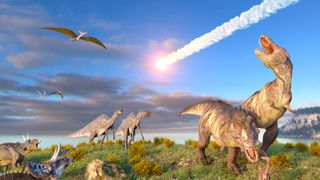Temperature inside Chicxulub crater after dinosaur-killing asteroid hit revealed with 'paleothermometer'
Researchers measured the temperature of the Chicxulub crater 66 million years ago, unlocking mysteries of the dinosaur-dooming mass extinction event.

Using a "paleothermometer," researchers have determined the temperature of the Chicxulub crater just after the dinosaur-killing asteroid created it 66 million years ago.
Rocks sampled from within the crater reached a sizzling 625 degrees Fahrenheit (330 degrees Celsius) at the end of the Cretaceous period (145 million to 66 million years ago), according to a study published Jan. 11 in the journal PNAS Nexus.
The new research also suggests that the asteroid impact didn't release as much carbon dioxide as previously thought, which could change the way scientists look at the mass extinction event that followed.
The Chicxulub crater formed when a 7.5-mile-wide (12 kilometers) space rock traveling at around 27,000 mph (43,000 km/h) slammed into Earth, creating a roughly 124-mile-wide (200 km) bowl in what is now the Gulf of Mexico. Violent tsunami waves helped refill most of the crater with sediment in the minutes and hours after the strike, and it was then buried beneath layers of rock laid down in the millions of years since the impact.
"You cannot access it that easily, but on the other hand, it's very well preserved," study lead author Pim Kaskes, a geologist at Université libre de Bruxelles in Brussels, told Live Science. "You just have to find the right rocks, the right material, and apply the right techniques to unravel its mysteries."
Related: Dinosaur-killing asteroid did not trigger a long 'nuclear winter' after all
Kaskes and his team studied samples taken from the peak ring region of the center of the impact crater in 2016. They applied carbonate clumped-isotope thermometry, or a paleothermometer, to the rocks; this method reconstructs ancient temperatures by detecting the abundance of the heavy carbon-13 and oxygen-18 isotope bonds in carbonate minerals.
Sign up for the Live Science daily newsletter now
Get the world’s most fascinating discoveries delivered straight to your inbox.
The temperature initially generated by the asteroid's strike would have been in the thousands to tens of thousands of degrees (F or C), but Kaskes noted that they couldn't measure that because those rocks were likely vaporized. They could, however, look for temperatures recorded in the rocks just after the initial strike.

The highest temperature signature, of 625 F, came from rocks collected more than 2,300 feet (700 meters) below the ocean floor. In the aftermath of the asteroid strike, these rocks were much warmer than the maximum temperature of the late Cretaceous ocean (95.9 F or 35.5 C) and what researchers would expect from burial and known hydrothermal activity beneath the crater (in the range of 120 to 390 F or 50 to 200 C), suggesting something else was going on.
"If you have temperatures above that range and the isotopic values lie outside the known hydrothermal values, you know most likely that there was another process involved," Kaskes said.
That process may have been thermal decarbonation and rapid back reaction, in which highly reactive calcium oxide (CaO) recombines with carbon dioxide (CO2) released from vaporized rock, forming new calcium carbonate (CaCO3) crystals, according to Kaskes. If that's the case, then less carbon dioxide entered the atmosphere following the asteroid strike than previously thought because lots of it was quickly reused for calcium carbonate.
Less carbon dioxide in the atmosphere could have reduced global warming and ocean acidification during the subsequent mass extinction event that killed 75% of all species, including nonavian dinosaurs, though researchers are still debating how the climate changed at the end of the Cretaceous.
The paleothermometer used in the new research sheds light on the events of 66 million years ago. It can also be applied to other impact craters around the world, opening up opportunities to learn more about asteroid strikes.
"They have had a huge effect on the evolution of life on our planet — look at the Chicxulub case," Kaskes said. "So knowing in detail how these processes work is crucial for us to understand the history of our planet and the history of our species."

Patrick Pester is a freelance writer and previously a staff writer at Live Science. His background is in wildlife conservation and he has worked with endangered species around the world. Patrick holds a master's degree in international journalism from Cardiff University in the U.K.
Most Popular



